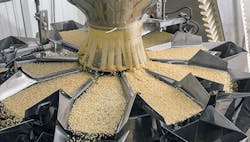Enclosure purge systems eliminate combustible-dust hazards
A significant number of my daily interactions at work have to do with food packaging lines that run dry goods. One of the main byproducts of the manufacturing process is we create a lot of dust.
Dust is everywhere. It comes in the form of nearly microscopic particles on dried fruits and vegetables. Dust is made when pieces of pasta or rice rub together in a tote or barrel.
Some of our lines involve cake and dessert mixes, where the dust is actually desired in this form. Other lines package dry cereal and oatmeal where, you guessed it, dust is created by the process of getting the product into the package that makes its way to the grocery shelf.
All of this dust makes it a challenge to keep things clean. Aside from the obvious hygienic concerns, dust can also make its way into the nooks and crannies of a machine where all the work gets done.
Slides and linear bearings, sprockets and chains, sensors—all of these components work very well until dust gets in or on them. Some of the products I encounter in my workplace can quickly reduce our packaging equipment to a malfunctioning mess. For instance, the finely ground sugar used for icing sugar is not only extremely fine and hard to control—it likes to flow everywhere—but it is also hygroscopic, meaning it likes to absorb moisture from the air. This can conspire to make a sticky mess that quickly wears down components and elevates maintenance concerns.
So, at this point you are probably wondering where I am going with all this. Sure, corn starch, baking soda and fine sugar create a mechanical nightmare, but how does that relate to controls?
Well, for controls there are an even more important risks—fire and explosions. The aforementioned materials have a low point of combustion, and, when switching devices are exposed to combustible materials, the results are, well, explosive.
In an industrial environment, the technology has evolved to a point where most on-machine components do not expose contacts to the environment. When working with combustible materials, we would likely defend against the obvious risks from the room environment, for example, by using totally enclosed motors and sealed sensors.
However, the inside of an electrical enclosure is an entirely different situation. We still have electrical components, most of which are IP20-rated, meaning that they are open to the air inside the enclosure and whatever other contaminants from outside the enclosure manage to get inside.
Sometimes the method of ingress is as obvious as opening the door of the enclosure, but the silent risk may actually be greater. That risk is from airborne contaminants that get in past leaky seals and the various panel penetration points like conduits, cable glands and bulkheads.
The obvious intent would be to seal up the enclosure to prevent any flash-point materials from getting in the enclosure in the first place. Sadly, no matter now tightly we seal the enclosure, the fact is there will always be a way for fine particles to make their way inside. Even if we could block up any holes, no matter how big or small, the very fact that there is a door on the enclosure means that every time that door is opened, the outside environment will get inside.
A means of expelling all the air once the enclosure door is latched and keeping outside air from getting back in while in operation is where purging systems come into play.
The general theory of a hazardous-environment purge system is to evacuate all of the air and airborne contaminants from the enclosure and then allow the control system to be energized. While the system is energized, the purge system will positively pressurize the enclosure such that the space inside the enclosure is at a higher pressure than the environment outside the enclosure. By doing so, we are basically creating an airflow that takes good, clean air from a reliable source and blows it into the enclosure.
If there are any cracks or holes, no matter how small, in the enclosure or any of its doors or penetrations—conduits or cable glands—the constant air supply at greater pressure than the outside air pressure, will prevent any dust or flammables from getting into the enclosure.
The key element in this type of system is to effectively evacuate the enclosure before allowing the control system to energize and open/close contacts that could cause an electrical arc—point of ignition.
Also read: Wrap it up: what you need to know about enclosures and the NEMA rating spectrum
Now some of you are probably thinking that you can’t just blow air into an enclosure as air; specifically, oxygen is something that can fuel combustion after ignition. You would be exactly correct. For this reason, instrument air or an inert gas is used for this purpose because, for obvious reasons, we don’t want to fuel the fire.
Let’s look at the classifications of hazardous area. There are three categories that we must talk about.
Div. 2 and/or Zone 2 is an area that is known to not have any concentrations of ignitable/flammable vapor, gas, liquid or dust during normal operation. If any of the above did exist, it would only be present during equipment breakdown or maintenance situations.
Div. 1 and/or Zone 1 is an area that is known to have concentrations of ignitable/flammable vapor, gas, liquid or dust during normal operation. If any of the above did exist, it would exist frequently during equipment breakdown or maintenance situations.
Div. 1 and/or Zone 0 is an area where concentrations of ignitable/flammable vapor, gas, liquid or dust are known to exist during normal operation and are present continuously or over long periods of time.
From the classification of the hazardous area, a means of purging can be determined. There are three types of purge—namely X, Y and Z.
Type Z purge will reduce the level of hazard from Div. 2 and/or Zone 2 down to nonhazardous. Purge can be manual and, once attained, can be maintained by keeping a positive pressure on the enclosure. Loss of pressure should be annunciated by an alarm or indicator. It is not necessary to remove the power source if the purge pressure is lost.
Type Y purge will reduce the level of hazard from Div. 1 and/or Zone 1 down to Div. 2 and/or Zone 2. Purge can be manual and, once attained, can be maintained by keeping a positive pressure on the enclosure. Loss of pressure should be annunciated by an alarm or indicator. It is not necessary to remove the power source if the purge pressure is lost.
Type X purge will reduce the level of hazard from Div. 1 and/or Zone 1 down to nonhazardous. However, unlike the Type Y purge, this purge time must be controlled by an automated system that maintains pressure in the enclosed area and an adequate exhaust flow from the enclosure. The power source must be removed if the purge pressure is lost or if adequate exhaust flow is not maintained.
Many commercially available products are available to both purge and provide positive pressure to an enclosure. Most enclosure vendors also have purge products that are specifically designed for use with their product lines.
The cost of the system will follow the severity of the risk. For example, the Type X purge system must be controlled and monitored automatically and must disconnect the source of power in the event of a failure in either the purging system or the exhaust system. The associated cost would be far greater than, for example, a Type Z purge system where there would only be a need for a supply of instrument air, a pressure sensor and an exhaust valve/vent.
One great side benefit of a purge system is it can also be used to control the ambient operating temperature of an enclosure. With the addition of a temperature sensor, the system can supply enough incoming gas and degree of exhaust to maintain an optimal operating temperature for the components inside the enclosure.
It is very important, after reviewing all this information, to understand the specifics of your operating environment and plan both the entire control system and, in particular, an appropriate purge/pressure system to match the needs.
To be honest, I have always focused on the obvious, like explosion-proof motors and toggle switches and the like. Perhaps that is because my exposure to such concerns involved control cabinets that were remote from the operating environment.
It is clear that, when the controls are in the same environment as the controlled machine or process, the concern elevates greatly. Remember, too, that if you have conduits traveling from the hazardous environment back to an enclosure in a control room, you still have the possibility of ignitable/flammable vapor, gas, liquid or dust that can penetrate the connection of the conduit and travel back to the control panel in that nice clean room if the inside of the control enclosure is at a lower pressure than the operating environment where the controlled components reside. We want the bad air out.
Rick Rice is a controls engineer at Crest Foods, a dry-foods manufacturing and packaging company in Ashton, Illinois. With more than 30 years’ experience in the field of automation, Rice has designed and programmed everything from automotive assembly, robots, palletizing and depalletizing equipment, conveyors and forming machines for the plastics industry but most of his career has focused on OEM in the packaging machinery industry with a focus on R&D for custom applications. Contact him at [email protected].
About the Author
Rick Rice
Contributing Editor
Rick Rice is a controls engineer at Trew Automation, a material handling manufacturer based in West Chester, Ohio. With over 38 years’ experience in the field of automation, Rice has designed and programmed everything from automotive assembly, robots, palletizing and depalletizing equipment, conveyors and forming machines for the plastics industry but most of his career has focused on OEM in the packaging machinery industry with a focus on R&D for custom applications.

Leaders relevant to this article:


